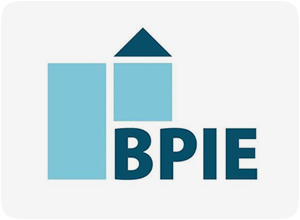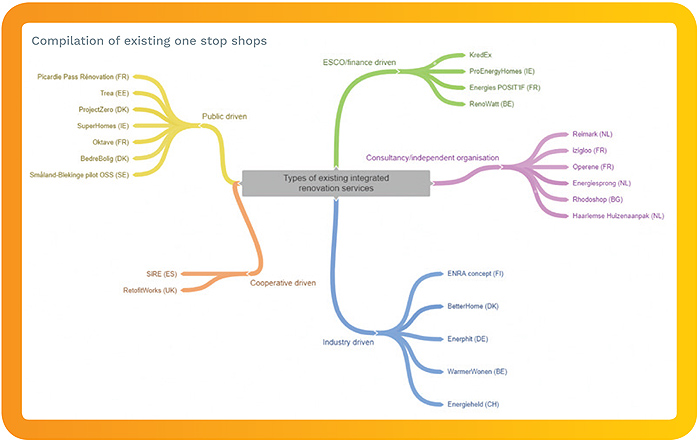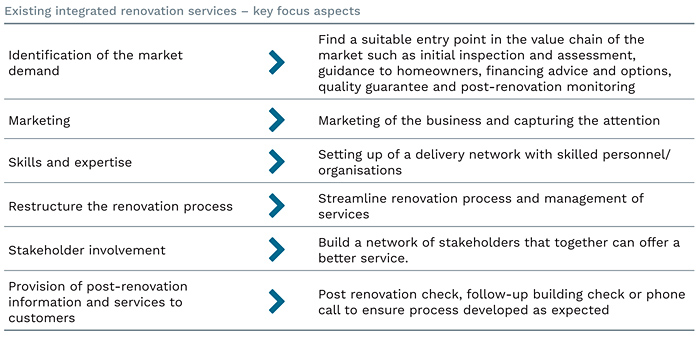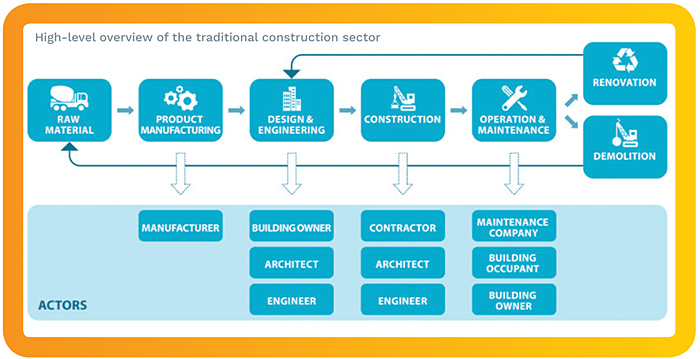 Renovation of existing buildings can lead to significant energy savings and play a key role in EU's clean energy transition. At the same time, the construction sector is crucial to Europe’s economic growth and its employment sector. In 2011, it was responsible for 7% of EU's gross domestic product and over eleven million people were directly employed in the building sector, making it the single largest contributor to employment in Europe1.
Renovation of existing buildings can lead to significant energy savings and play a key role in EU's clean energy transition. At the same time, the construction sector is crucial to Europe’s economic growth and its employment sector. In 2011, it was responsible for 7% of EU's gross domestic product and over eleven million people were directly employed in the building sector, making it the single largest contributor to employment in Europe1.
The renovation value chain differs from other sectors’, as it involves multiple actors within a single process. The fragmented value chain makes it difficult for the owner to predict renovation works and estimate their cost. A high-level overview of the traditional construction sector from a life cycle perspective shows the conventional actors involved at different stages2.
Policymakers3, researchers and companies have concluded that by simplifying the renovation process for owners, demand for energy renovations can increase, especially with integrated renovation services where the new business models align multiple services and actors.
BPIE launches a report for the Horizon2020-funded Turnkey Retrofit project4, outlining existing research on one-stop-shops and integrated renovation services. The benchmarking exercise presents nine integrated renovation services, deriving lessons-learnt and guidelines for the Turnkey Retrofit service with a focus on: target audiences; offered services; relations between involved stakeholders; data required; financial model; number of supported projects and more. Key aspects are presented here, highlighting promising examples from across Europe.

One stop shops (OSS) provide integrated renovation services for existing buildings. The interest for them increased after the recast of the European Performance of Buildings Directive [2010/31/EU], which called for improved advisory tools for consumers. To fill the void between the supply and demand side and unburden the customer, innovative user-oriented services began to emerge in Europe.
OSSs offer a turnkey solution for clients, better communication, knowledge-sharing and the potential to minimise the risk of errors in the process.5 Most focus on residential buildings, including single-family houses, multi-family buildings, as well as social housing and public buildings, while commercial buildings are less often subject to them. The existing integrated renovation services focus on six central aspects (see table below).
Nine integrated renovation services launched in the past 6 years are studied in the report: Operene, izigloo, Oktave, SiRE, SuperHomes, ProEnergy Homes, BetterHome, Energiesprong and Retrofitworks.
Most still struggle to achieve enough scale, required to lower costs, reorganise and streamline the value-chain and become the natural go-to solutions. First results include: Izigloo reached the largest number of supported projects but the model supports smaller renovation measures. Operene supported deep renovation of around 4.000 dwellings, Energiesprong around 3.886 net-zero energy renovations, SiRE 74, BetterHome 1182, Oktave 180, SuperHomes around 200, RetrofitWorks 250. As for ProEnergy Homes, it has just started and no renovation has been completed yet.
The services were initiated by a heterogenous group of actors. Izigloo and Operene are both governed by independent private organisations, while Oktave and Energiesprong are governed by a mix of private and public actors. ProEnergyHomes and SiRe are private membership associations, while BetterHome is governed by four private manufacturers (Rockwool, Danfoss, Velux6 and Grundfos). SuperHomes is governed by a regional energy agency.


An integrated renovation service needs to align the work of multiple actors, such as architects, energy experts, contractors and installers. An effective collaboration is key to a successful implementation of the works.
Several models (Oktave, Operene, SuperHomes, ProEnergyHomes) have employed project managers while the actual construction work is conducted by an external partner. Other models (Izigloo, BetterHome, RetrofitWorks, SiRe) focus on matching the renovation project with the right installers and contractors and leaves them the project management.
Many use an online portal. The key activities provided by the models include technical and financial aspects of the renovation service. Most integrate training for experts to be able to give reliable information about energy renovation alternatives and/or how to best approach the customer.
The diversity of revenue streams in the nine models illustrate how differently the business models have been developed. The most common is to get a compensation for every completed project. A couple of projects take out membership fees. Several receive support funds from third parties. Energy performance contracting is another revenue stream for larger projects.
The Horizon2020-funded project Turnkey Retrofit will be a new OSS offering an integrated renovation service for both single-family and multi-family buildings using the solutions and infrastructure of Izigloo and Operene and incorporating best practices and learnings from the cases referred to above.
It will develop and replicate an integrated home renovation service operated in France, Ireland and Spain, transforming the complex and fragmented renovation process into a simple, straightforward and attractive process for the homeowner. It will include the initial technical and behavioural diagnosis, technical offer, contract development and agreement, structuring and provision of financial support, as well as the on-site coordination of works and quality assurance.
Accessible through a digital platform (Solutions4Renovation), it will address drivers of building renovation beyond reducing energy bills and increasing asset value, such as home improvement, increased comfort, enhanced health and quality of life.
Most successful OSSs have a strong network in the markets they are active in and should be embedded in a larger policy framework in order to be effective. Some food for thought for future work!
Contact information
For more information on BPIE's work visit www.bpie.eu
1. European Commission -. JRC, "Energy Renovation: The Trump Card for the New Start for Europe," 2015
2. Buildings Performance Institute Europe (BPIE) and i2-4c, "Driving Transformational Change in the Construction Value Chain," 2017
3. The amended Energy Performance of Buildings Directive [2018/844] stressed the importance of one-stop-shops to improve energy advice and increase investments in energy renovations (see article 2a and 20(2)
4. www.turnkey-retrofit.eu, project n°839134.
5. K. Balson, M. Moreira and L. Simkovicova, “Financing step-by-step energy efficient refurbishment,” EuroPHit, 2016
6. Velux later left the BetterHome board